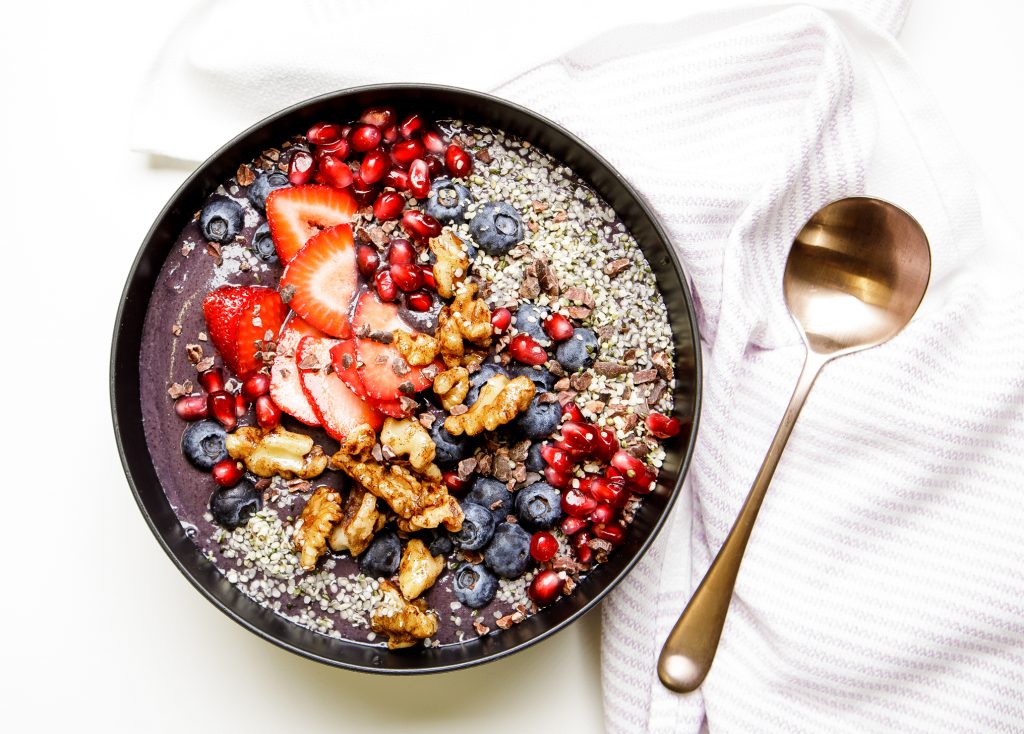Glorious Pomegranate

On top of being a brilliant shade of red and absolutely delicious, pomegranates are loaded with beneficial compounds. Research is uncovering the many ways in which they help fight disease and optimize health. But before exploring how this fruit works to support the human body, let’s learn a little more about the plant itself.
The pomegranate is a small fruit-bearing tree that can live over 200 years. They originated in the region from modern-day Iran to northern India. They have been cultivated throughout the Middle East, South Asia, and the Mediterranean for thousands of years, and are even grown in the United States in the drier climates of California and Arizona. In the U.S., they are in season from September to December. While they technically belong to the berry family, pomegranate means “apple with many seeds.”
In ½ cup of pomegranate arils (seeds), you will get:
- 72 calories
- 3.5 grams of fiber
- 16 grams of carbohydrates
- 12 grams of sugar
- 1.5 grams of protein
- Vitamin K: 18% DV (Daily Value)
- Vitamin C: 15% DV
- Folate: 8% DV
- Potassium: 6% DV
Polyphenols, Antioxidants, and More
In addition to fiber, vitamins, and minerals, there is a lot more that pomegranates have to offer. Although more research is needed to confirm many of the findings below, here is a brief summary of what some of the research shows to date:
- Of all the pomegranate research available, there is most evidence to support its impact on reducing blood pressure, specifically systolic blood pressure (the top number). This meta-analysis from eight clinical studies of 574 patients showed that pomegranate juice reduced systolic blood pressure by about 5 mmHg. For people with a systolic blood pressure above 140 mmHg, a reduction of 1 mmHg results in a 5% decreased risk of stroke.
- Tannins and anthocyanins are two polyphenols found in pomegranates that may actually help prevent and control type 2 diabetes. Preliminary research has shown that moderate amounts of pomegranate juice, 1.5mL per kilogram of body weight, reduces fasting blood glucose by about 17 mg/dL, improves beta-cell function, and decreases insulin resistance. However, about 20% of patients had increased blood glucose levels after drinking pomegranate juice, so it is best to speak with a knowledgeable health care practitioner before adding juice to your diet if you are a type 2 diabetic.
- Pomegranate extract is a rich source of ellagitannins, which increases the gut bacteria Akkermansia muciniphila in the stool. Akkermansia has an inverse relationship with obesity, diabetes, inflammation, and metabolic disorders. In other words, when you have a healthy amount of Akkermansia in the gut, you are better protected against those conditions.
- Polyphenols in pomegranate seeds have been shown to be anti-inflammatory and cardioprotective. Some research demonstrated that drinking 50mL of pomegranate juice daily helped reduce plaque buildup in the carotid artery by up to 35% after one year.
- Pomegranates support phase I and II liver detoxification through its Nrf2 activity. Nrf2 is a protein that protects against oxidative damage that is triggered by injury and inflammation.
- A little pomegranate syrup may help alleviate nausea and vomiting in pregnant women.
Don’t Forget the Fruit!
As you can see from the list above, much of the research has been done on pomegranate juice/concentrates. While the juice and concentrates do seem to have a lot to offer, let us not forget the most important thing of all: the pomegranate fruit! Eating the whole seeds will not only provide a huge antioxidant punch, but you will also get fiber from the inner seeds along with several health-promoting compounds that we might be losing through processing. As tempting as it is to isolate one part of a plant to find the health benefits, we must remember the synergistic qualities you get from eating a whole food. In fact, whole pomegranate seeds have more potent anti-tumor and in vitro chemical effects compared to some of their individual constituents. With all of that said, while incorporating a little juice or extract may be of benefit to many, I suggest your first choice be the whole pomegranate seed straight from the fruit along with a whole food, nutrient-dense diet! They are great in salads, on top of dairy-free yogurt, mixed in with muesli, or even as a garnish for savory dishes such as chicken or lamb.
As amazing as all of this sounds, there is one vital question we must ask for those looking to enjoy the pomegranate fruit: how do you open it?! There are actually many ways to do this. I typically fill up a large bowl with water until it covers the whole pomegranate. Then I will cut the pomegranate into quarters using a large sharp knife while it is submerged in the water. This prevents the juice from spraying and staining my clothes or anything in its path! From there, I simply use my fingers to remove the seeds which will sink to the bottom while the white pulp floats to the top and can easily be grabbed and discarded.
Another method is to cut the pomegranate in half and then score each half of the exterior rind four to six times along the ridges. Hold the pomegranate half over a bowl and smack the rind with a spatula or large spoon. This should get most of the seeds out and only leave a few left to take out by hand.
Be Sure to Balance Your Blood Sugar
Whether you decided to incorporate the seeds, pomegranate juice, powders, or a combination, it is important to be mindful that they do contain naturally occurring sugar, largely fructose and glucose. Take steps to balance this out by eating a source of protein or fat at the same time to slow down the absorption of the sugar. For example, if you have pomegranate seeds as a snack, pair them with a handful of walnuts or pecans. If you decide to incorporate juice, keep in mind you are losing the beneficial fiber from the fruit which increases the glycemic index. Putting the juice in a smoothie that contains some fat such as avocado, protein powder, and/or fiber can help balance this out. Look for organic 100% juice and dilute with a little water. If you choose juice, I recommend limiting to ¼ to ⅓ cup and if you choose juice concentrate, limit to ½ to 1 ounce (1-2 tablespoons) and enjoy it with a meal. Lakewood and Dynamic Health are two great companies that offer high-quality options. You can also get pomegranate powder which contains minimal sugar, such as this one from Micro Ingredients.
I hope you’re feeling inspired to embrace the power of the pomegranate! To get you started, here is one of my favorite recipes from Dr. Hyman’s soon to be released cookbook, Food: What the Heck Should I Cook?
Superfood Smoothie Bowl
Serves: 1
Prep Time: 5 minutes
Cook Time: 8 minutes
Ingredients:
Spiced Walnuts
- 1⁄4 cup raw walnuts, chopped and toasted
- 1⁄4 teaspoon ground cinnamon
- Pinch of sea salt
Smoothie Base
- 1 cup loosely packed baby spinach
- 1⁄2 cup frozen blueberries
- 1⁄4 cup frozen cauliflower
- 1⁄2 cup filtered water
- 1 tablespoon MCT oil
- 1 tablespoon almond butter
- 1 teaspoon lemon juice
- 1 teaspoon vanilla extract
- 1 teaspoon spirulina powder, plus more for garnish
- 1 teaspoon micro-grated peeled fresh ginger
- 1⁄4 teaspoon ground cinnamon
Toppings
- 1⁄4 cup fresh blueberries
- 1⁄4 cup chopped fresh strawberries
- 2 teaspoons pomegranate seeds
- 11⁄2 teaspoons cacao nibs 1 teaspoon hemp seeds
Method:
- For the walnuts: Preheat the oven to 350°F. Place the walnuts on a baking sheet and toast for 8 minutes, until fragrant. In a small bowl, combine the walnuts with the cinnamon and salt. Toss to coat, then set aside to cool.
- For the smoothie base: Combine all the ingredients in a high-speed blender and purée until smooth.
- For the toppings: Pour the smoothie into a bowl and garnish with the spiced walnuts, blueberries, strawberries, pomegranate seeds, cacao nibs, and hemp seeds. Sprinkle a dusting of spirulina on top and enjoy.

